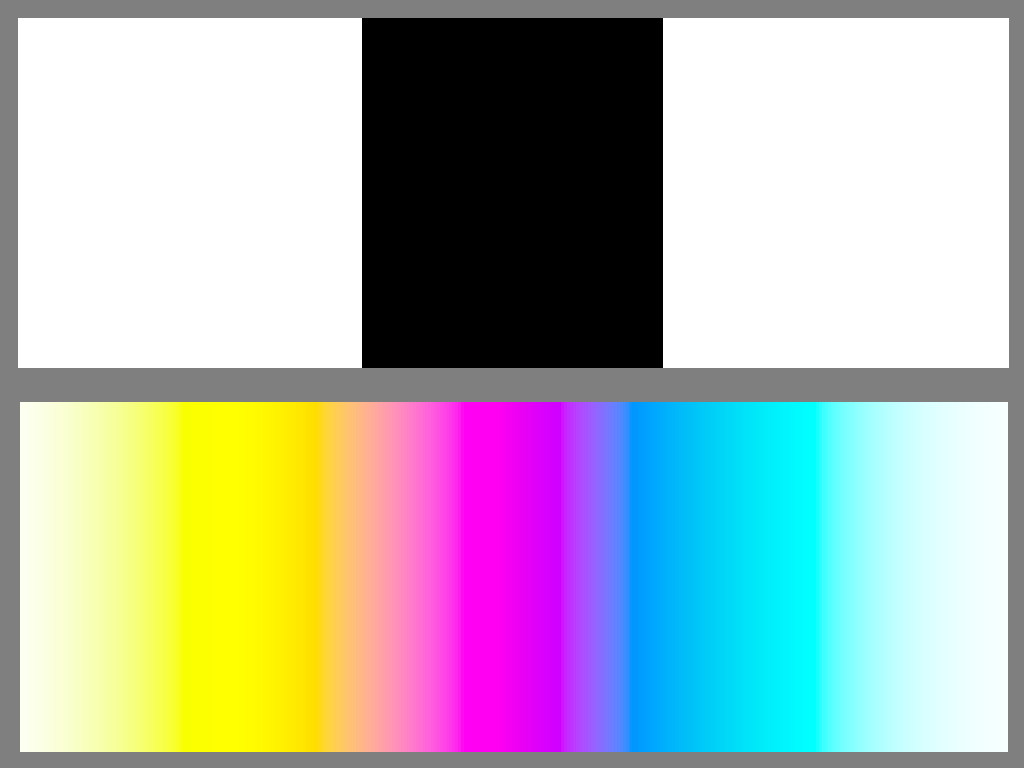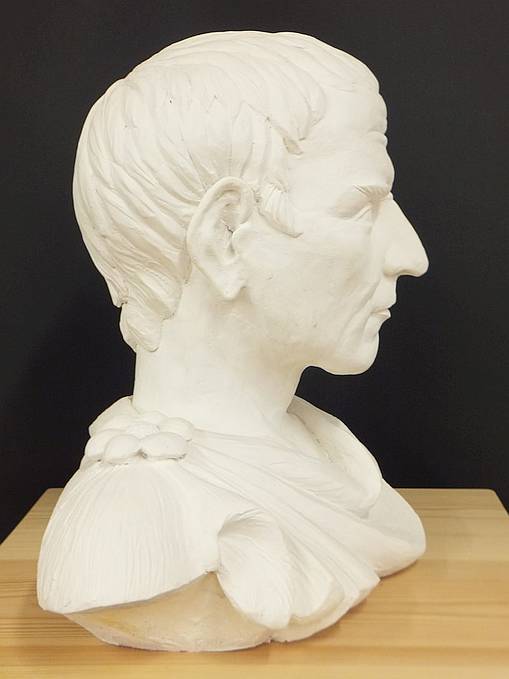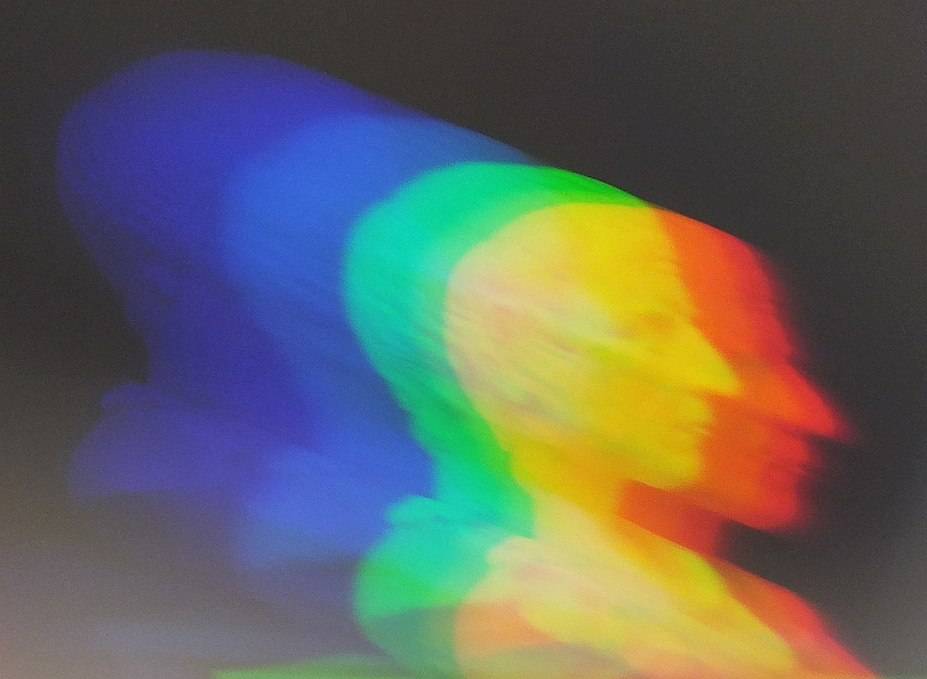
Black bar on white ground and the so-called bar spectrum or Goethe spectrum
| Dietrich Zawischa | Contact | Deutsche Version |
There has never been a dispute between Goethe and Newton (Newton died in 1727 and Goethe was born in 1749), but there has been a violent polemic by Goethe against Newton's conclusions from the experiments with the prism. I have already written about Goethe's theory of colours and physics at his time (link, only in German); this is about more recent attempts to “rehabilitate” Goethe's theory of colours, what is apparently hoped for by many people.
Newton was the first to investigate the colour phenomena that can be observed in the refraction of light. His experimental setup was very simple. A small hole in the shutter, a glass prism behind it, and on the opposite wall a “spectrum” appeared, thus a ghostly strange phenomenon in the original meaning of the word.
The word “spectrum” now has a precise meaning in physics, similarly also in mathematics, and from the point of view of modern physics (and also of physics in Goethe's time), what Newton saw is only a rough approximation to the spectrum of sunlight: the superposition of the coloured pinhole camera sun images on the wall, which are deflected to different degrees depending on the refrangibility of the rays. Newton interpreted this fact correctly and drew the right conclusions from it, which were then fought vehemently by Goethe, who could not accept that white light should be composite and made up from different colours.
Goethe thought he had discovered the unexplainable “basic phenomenon” of colour formation (see "scattering") and attempted to derive the prismatic colours from it in a mysterious way. For example, when looking through a prism on a black bar on a white background, the light would be pulled over the darkness on one side and the darkness over the light on the other side, thereby producing colours, the prism acting like a turbid medium. With respect to colour generation, Goethe believed in a complete symmetry between white and black or even light and darkness.

However, the different “spectra” that are presented are not spectra in the strict sense; they are always obtained from a more or less wide slit or bar. And the light source is always white light, i.e. sunlight, daylight or lamp light. The philosopher of science admits that all inverted experiments can be interpreted with Newton's theory, but he ignores the progress of science since Newton's time and that there are experiments with light that cannot be inverted, in particular all experiments in which spectra in the strict sense are studied. Even during Goethe's lifetime, Fraunhofer saw and measured the dark lines in the spectrum of sunlight. Can spectroscopy be performed by placing a narrow bar in the broad luminous flux to be investigated instead of a narrow slit? So, for example, to make the Fraunhofer lines visible as bright lines in the bar spectrum?
The polarity is not as perfect as Goethe thought and Müller claims, see the prism experiments. Müller emphasizes the predictive power of Goethe's theory of colour. I would be interested in the experimental confirmation of the following prediction:
(The inverted rainbow would be completely outshone by the reflections of the shining and dazzling glow on the raindrops and would certainly not be visible, not even in laboratory experiments.)
The symmetry between black and white that has come to the fore here is not the reason why physicists reject Goethe's theory of colours, but his assertion that white light cannot be split up and that all colours, especially prismatic ones, are created by the interaction between light, darkness and turbidity. Müller does not go into this, only says that he does not understand this “theory”, that nobody has understood it correctly so far and that it apparently does not work either [2]. Goethe expresses himself clearly, it is quite understandable what he means.
The so-called Goethe spectrum, by the way, was already known to Newton and was correctly explained by him. The reversal of Newton's experiments does not bring any new knowledge, and for this reason physicists are barely interested in it. Müller claims that there is no experiment that would allow to distinguish between Newton's theory of the heterogeneity of sunlight and the opposite hypothesis of the heterogeneity of the darkness [3].
How about this experiment, which Newton could have already done: instead of a small hole in the shutter, now a wider strip is cut out, wide enough so that the prism fits exactly into the opening, so no shadow falls on the prism and no light passes it.
In the reverse experiment, one would have to place a wide black stripe in front of the prism so that no direct sunlight hits it, and open the shutter wide so that no shadow is created around it …
Links (all in German): [1] Color dispute — [2] What would Newton have had to answer to Goethe's experiments? — [3] When poets defeat physicists
Zinke attempts to defend Goethe's central notion of the indivisibility of white light and the emergence of prismatic colours and to debunk Newton's explanation.
He's also experimenting with white light. He defines the term spectrum even broader than Müller: very wide “slits” (white stripes on dark ground), bars and also arbitrary figures, viewed through the prism, he calls spectra. After looking at such “spectra” from different light sources (sun, candle, incandescent lamp, fluorescent tube, LED), he comes to the conclusion (p. 23): “In natural and artificial light sorts the same spectral colours are regularly produced.” and (private communication, 19 May 2019): “Once one is convinced of the fundamental equality of the spectra, artificial light sources are more suitable for study purposes.” And so it happens that he carries out most experiments with light from a fluorescent lamp and claims that the results thus obtained are generally valid.
“The spectral colours are clearly defined and can be precisely determined as areas in colour and number” (p. 35).
However, the alleged results contradict not only Newton's but also Goethe's teaching. Zinke therefore tries at least with the designation „Nebenbild“ (secondary image) to remain close to Goethe's terminology, whereby, however, the main picture is again something different than with Goethe. Goethe's attempt to explain the origin of colour is rejected and replaced by the “ formation” of three strong and three weak, already coloured secondary images, which are somehow supposed to come about by the reflections at the prism surfaces. Although the book (p. 57) also contains spectra obtained by means of diffraction gratings, the fact that these spectra contradict his basic assumption of image formation is ignored. The main thing is that the three strong and three weak secondary images of the fluorescent lamp “are generated”.
Zinke quotes (p. 16) Goethe's comments on “Fraunhofer's experiment, where transverse lines appear in the spectrum”, and does not notice that Fraunhofer's results brilliantly confirm Newton's as regards the composition of sunlight from differently refrangible fractions. Wouldn't Fraunhofer have noticed the three strong and three weak secondary images if they existed?


On p. 59 it is quoted from Wikipedia: “1801: Thomas Young assumes that the possibility of combining all colours from three primary colours is based on physiological processes in the retina and suggests three receptor types that match the primary colours. Hermann von Helmholtz extended this model to three-colour theory around 1850.” – but in the following the fact that the three primary colours are physiologically determined gets lost and is even disputed (p. 94): “Although the human visual organ is demonstrably based on the RGB system imitated by the printing industry, the tripartite structure of the spectral image cannot originate from the eye. Since all spectra have so far been perceived as continuous, the eye cannot be responsible for the tripartition of the spectral image »here«.”
He thus assumes that spectra have so far only been perceived as continuous because it has not been possible to draw the secondary images far enough apart.
As already the word “spectrum” has a different meaning here than usual in physics, this also applies to other terms like “spectral colours” and “monochromatic”. This leads to statements like the following (p.147): “The magenta colour is a primary colour in the bar spectrum. It is therefore a true spectral colour, which must be classified in a new scheme . … However, this classification collides with the assignment of the so-called »refraction angle« and the resulting »wavelength«. Therefore, with the recognition of magenta as a true spectral colour, a recalculation of these two quantities is necessary.”
The wavelengths in the visible spectrum approximately range from 380 nm to 720 nm. There is no single wavelength which corresponds to the visual impression of magenta. Apparently Zinke wants to change that.
I'd like to skip the rest of the book. Only one sentence from the very last section “Open Questions” “which are to be handed over to the scientific curiosity of the younger generation” on p. 523: “How exactly do the coloured secondary images arise in the prism?”
That'll do. The book should not have been written until this question had been resolved.